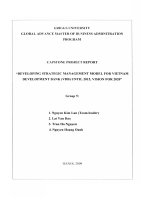Strategic management planning for domestic and global competition 14th ed pearce robinson chapter 8
Bạn đang xem bản rút gọn của tài liệu. Xem và tải ngay bản đầy đủ của tài liệu tại đây (734.07 KB, 36 trang )
Chapter 8
Business
Strategy
© 2015 by McGraw-Hill Education. This is proprietary material solely for authorized instructor use. Not authorized for sale or distribution
in any manner. This document may not be copied, scanned, duplicated, forwarded, distributed, or posted on a website, in whole or part.
Learning Objectives
• Determine why a business would choose a low-cost,
differentiation, or speed-based strategy
• Explain the nature and value of a market focus strategy
• Illustrate how a firm can pursue both low-cost and
differentiation strategies
• Identify requirements for business success at different
stages of industry evolution
• Determine good business strategies in fragmented and
global industries
• Decide when a business should diversify
Basic Issues in Business Strategy
• What strategies are most effective at building
sustainable competitive advantages for single
business units?
• Should dominant-product/service businesses
diversify to build value and competitive
advantage?
Evaluating and Choosing Business Strategies: Seeking Sustained
Competitive Advantage
•
•
The two most prominent sources of competitive
advantage can be found in the business’s cost
structure and its ability to differentiate the
business from competitors
Businesses that have one or more
sources/capabilities that let them operate at a
lower cost will consistently outperform their
rivals that don’t.
Evaluating Cost Leadership Opportunities
•
Business success built on cost leadership
requires the business to be able to
provide its product or service at a cost
below what its competitors can achieve
Low-cost Strategies
• Business strategies that seek to establish longterm competitive advantages by emphasizing
and perfecting value chain activities that can
be achieved at costs substantially below what
competitors are able to match on a sustained
basis. This allows the firm, in turn, to
compete primarily by charging a price lower
than competitors can match and still stay in
business.
Ex. 8.1
Evaluating a Business’s Cost Leadership Opportunities
Sustainable Low-Cost Activities
1. Some low-cost advantages reduce the likelihood of
buyers’ pricing pressure
2. Truly sustained low-cost advantages may push rivals into
other areas
3. New entrants competing on price must face an
entrenched cost leader
4. Low-cost advantages should lessen the attractiveness of
substitute products
5. Higher margins allow low-cost producers to withstand
supplier cost increases
Risks of a Cost Leadership Strategy
1. Many cost-saving activities are easily duplicated
2. Exclusive cost leadership can be a trap
3. Obsessive cost cutting can shrink other
competitive advantages
4. Cost differences often decline over time
Evaluating Differentiation
• Differentiation requires that the business have
sustainable advantages that allow it to provide
buyers with something uniquely valuable to them
• Differentiation usually arises from one or more
activities in the value chain that create a unique
value important to buyers
• Strategists use benchmarking and consider the 5
forces in considering differentiation
Differentiation
• A business strategy that seeks to build
competitive advantage with its product or
service by having it be “different” from other
available competitive products based on
features, performance, or other factors not
directly related to cost and price. The
difference would be one that would be hard
to create and/or difficult to copy or imitate.
Ex. 8.3
Evaluating a Business’s Differentiation Opportunities
Evaluating Speed as a Competitive Advantage
• Speed-based strategies, or rapid
response to customer requests or
market and technological changes,
have become a major source of
competitive advantage for numerous
firms in today’s intensely competitive
global economy
Ex. 8.6
Evaluating a Business’s Rapid Response
(Speed) Opportunities
Speed can be created by:
•
Customer responsiveness
•
Product development cycles
•
Product or service improvements
•
Speed in delivery or distribution
•
Information Sharing and Technology
Risks of Speed-based Strategy
• Speeding up activities that haven’t been conducted in a
fashion that prioritizes rapid response should only be
done after considerable attention to training,
reorganization, and/or reengineering
• Some industries may not offer much advantage to the
firm that introduces some forms of rapid response
• Customers in such settings may prefer the slower pace or
the lower costs currently available, or they may have
long time frames in purchasing
Evaluating Market Focus as a Way to Competitive Advantage
•
•
•
Market focus: the extent to which a
business concentrates on a narrowly
defined market
Small companies, at least the better
ones, usually thrive because they serve
narrow market niches
Market focus allows some businesses to
compete on the basis of low cost,
differentiation, and rapid response
against much larger businesses with
greater resources
Market Focus
• This is a generic strategy that applies a
differentiation strategy approach, or a lowcost strategy approach, or a combination –
and does so solely in a narrow (or “focused”)
market niche rather than trying to do so
across the broader market. The narrow focus
may be geographically defined by product
type features, or target customer type, or
some combination of these.
Risks of Market Focus
•
The risk of focus is that you attract major competitors
who have waited for your business to “prove” the
market
•
Publicly traded companies built around focus
strategies become takeover targets for large firms
seeking to fill out a product portfolio
•
Slipping into the illusion that it is focus itself, and not
low cost, etc. that is creating the business’s success.
Stages of Industry Evolution and Business Strategy
Choices
•
The requirements for success in industry segments
change over time
•
Strategists can use these changing requirements,
which are associated with different stages of
industry evolution, as a way to isolate key
competitive advantages and shape strategic
choices around them
Emerging Industries
• Emerging industries are newly
formed or re-formed industries that
typically are created by
technological innovation, newly
emerging customer needs, or other
economic or sociological changes
• There are no “rules of the game”
Business Strategies in Emerging Industries
• Technologies that are most proprietary to the pioneering firms and
technological uncertainty will unfold
• Competitor uncertainty because of inadequate information about
competitors, buyers, and the timing of demand
• High initial costs but steep cost declines
• Few entry barriers
• First-time buyers requiring initial inducement to purchase
• Inability to obtain raw materials and components until suppliers gear up to
meet the industry’s needs
• Need for high-risk capital because of the industry’s uncertain prospects
Emerging Industries
•
•
•
•
•
•
For success in this industry setting, business strategies
require one or more of these features:
The ability to shape the industry’s structure
The ability to rapidly improve product quality and
performance features
Advantageous relationships with key suppliers and
promising distribution channels
The ability to establish the firm’s technology as the
dominant one
The early acquisition of a core group of loyal customers
and then the expansion of that customer base
The ability to forecast future competitors
Competitive Advantages and Strategic Choices in Growing Industries
•
Rapid growth brings new competitors into the
industry
•
At this stage, growth industry strategies that
emphasize brand recognition, product
differentiation, and the financial resources to
support both heavy marketing expenses and the
effect of price competition on cash flow can be key
strengths
Growth Industries
• For success in this industry setting, business strategies require one or
more of the following features:
• The ability to establish strong brand recognition
• The ability and resources to scale up to meet increasing demand
Strong product design skills to be able to adapt products and services
The ability to differentiate the firm’s product[s] from competitors entering
the market
R&D resources and skills to create product variations
The ability to build repeat buying from established customers
Strong capabilities in sales and marketing









